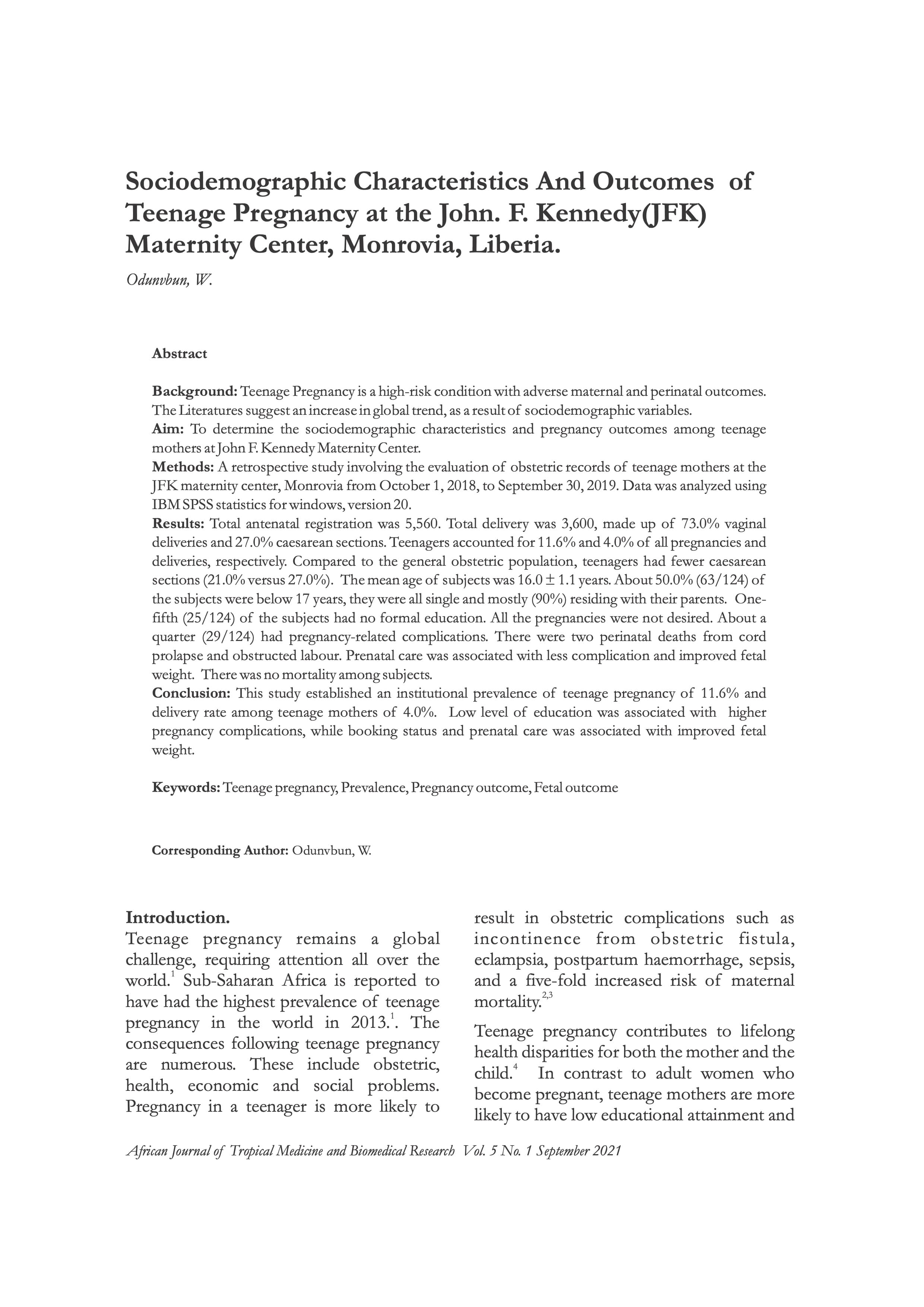The Sociodemographic Characteristics And Outcomes of Teenage Pregnancy at the John. F. Kennedy (JFK) Maternity Center, Monrovia, Liberia
Abstract
Background: Teenage Pregnancy is a high-risk condition with adverse maternal and perinatal outcomes. The Literature suggests an increase in the global trend as a result of sociodemographic variables.
Aim: To determine the sociodemographic characteristics and pregnancy outcome among teenage mothers at John F. Kennedy Maternity Center.
Methods: A retrospective study involving evaluating obstetric records of teenage mothers at the JFK maternity center, Monrovia, from October 1, 2018, to September 30, 2019. Data was analyzed using IBM SPSS statistics for windows, version 20.
Results: Total antenatal registration was 5,560. Total delivery was 3,600, made up of 73.0% vaginal deliveries and 27.0% caesarean sections. Teenagers accounted for 11.6% and 4.0% of all pregnancies and deliveries, respectively. Compared to the general obstetric population, teenagers had fewer caesarean sections (21.0% versus 27.0%). The mean age of subjects was 16.0 ± 1.1 years. About 50.0% (63/124) of the subjects were below 17 years, they were all single and mostly (90%) residing with their parents. One-fifth (25/124) of the subjects had no formal education. All the pregnancies were not desired. About a quarter (29/124) had pregnancy-related complications. There were two perinatal deaths from cord prolapse and obstructed labour. Prenatal care was associated with less complication and improved foetal weight. There was no mortality among subjects.
Conclusion: This study established an institutional prevalence of teenage pregnancy of 11.6% and a delivery rate among teenage mothers of 4.0%. A low level of education was associated with higher pregnancy complications, while booking status and prenatal care were associated with improved foetal weight.
References
United Nations Population Fund. Motherhood in Childhood: Facing the challenge of adolescent pregnancy. New York: UNFPA, 2013.
World Health Organization. Adolescent Pregnancy. Secondary Adolescent 2014. Available from: http://www.who.int/maternal_child_adolescent/topics/maternal/adolescent_pregnancy/en/. Accessed 10/03/2021, 5:35.
Macleod CI, Tracy T. A decade later: follow-up review of South African research on the consequences of and contributory factors in teenaged pregnancy. S Afri J Psychol 2010;40(1):18-31.
Moisan C, Baril C, Muckle G, Belanger RE. Teen pregnancy in Inuit communities- gaps still needed to be filled. Int J Circumpolar Health 2016;75:31790.
Chen XK, Wen SW, Fleming N, Demissie K, Rhoads GG, Walker M. Teenage pregnancy adverse birth outcomes: a large population-based retrospective cohort study. Int J Epidemiol 2007;36:368.
Saudi J, Mitrou F, Lawrence D, Stanley FJ, Silburn SR, Zubrick SR. Antecedents of teenage Pregnancy from a 14-year follow-up study using data linkage. BMC Public Health, 2010;10:63.
American OE. A comparative analysis of predictors of teenage pregnancy and a rural town in Western Nigeria. Int. J. Equity Health 2015;12(1):1-7.
Isa AI, Gani IOO. Socio-demographic determinants of Teenage Pregnancy in the Niger Delta of Nigeria. Open J Obstet Gynecol 2012;2:239-243
Ogunlesi TA, Ayeni VA, Jagun EO, Ogunfowora OB. Socio-Clinical factors related to the perinatal outcome of teenage pregnancy in a Nigerian Teaching Hospital. Niger J Paediatr. 2013;40(3):290-4.
Palermo T, Peterman A. Are female Orphans at Risk for Early Marriage, Ear sexual Debut, and Teen Pregnancy? Evidence from Sub-Saharan Africa. J Fam Plann 2009;40(4):101-12.
Abdulkarim SM. Adolescent health and health care in the Arab Gulf countries: Today’s needs and tomorrow’s challenges. Int J Pediatr Adolesc Med 2017;4(1):1-8.
Ajonina MU, Abong RA, Nfor CK, Akomoneh EA, Ware KB, Atanga SN. Pregnancy Outcomes and Risk Factors among Adolescents in Buea Health District, Southwest Region, Cameroon: A Comparative Study 2018 IJTSRD;2(2): 1018-28.
First Liberian Civil war https://www.bbc.com/news/world-africa-1372950. Available from en.m.wikipedia.org. Accessed 11/03/2021. 08:51
United Nations. Fertility Levels and Trends as assessed in the 2012. Revision of the world population prospects. New York: United Nations, 2013.
Olurunfemi EA. A comparative analysis of predictors of Teenage Pregnancy and its prevention in a rural town in Western Nigeria. Int J Equity Health 2012;11:37.
Tamramat IR, Sahr FB. Teenage pregnancy and implications on child survival amongst mothers attending a clinic in the East- End, Freetown, Sierra Leone. OJPed 2013;3:294-299. DOI:10.4236/ojped.2013.34053.
Sedge G, Finer LB, Bankole A, Eilers MA, Singh S. Adolescent pregnancy, birth, and abortion rates across countries: levels and recent trends. J Adolesc Health 2015;56(2):223-30.
Odimegwu C, Mkwananzi S. Factors Associated with Teen pregnancy in Sub-Saharan Africa: A multi-Country cross-Sectional Study. African J Reprod Health 2016;20(3):94-107.
Nicholas D, Woods ET, Gates DS, Sherman J. Sexual behavior, contraception practice and, reproductive health among adolescents. Stud Fam 1987;18(3):167-76.
Leclerc-Madlala S. Transactional sex and the pursuit of modernity. 2008:213-233 https://doi.org/10.1080/02533950308628681.
Shaw M, Lawlor DA, Najman JM. Teenage children of Teenage mothers: psychological, behavioural and health outcomes from an Australian prospective longitudinal study. Soc. Sci & Med 2006;62(10):2526-39.
De Vinne CM, Creveuili, and Dreyfus. Does young maternal age increase the risk of adverse obstetric, fetal and neonatal outcomes: a cohort study. Eur J Obstet Gynecol Reprod Biol 2009;147(2):151-6.
Chantrapanichkul P, Chawanpaiboon S. Adverse pregnancy outcomes in cases involving extremely young maternal age. Int. J Obstet. Gynecol 2013;120(2):160-164
Thaithae S, Thato R. Obstetric and perinatal outcomes of teenage pregnancies in Thailand. J Pediatr and Adolesc Gynecol 2011;24(6):342-346.

Downloads
Published
Issue
Section
License
Copyright (c) 2022 African Journal of Tropical Medicine and Biomedical Research

This work is licensed under a Creative Commons Attribution-ShareAlike 4.0 International License.
Key Terms:
- Attribution: You must give appropriate credit to the original creator.
- NonCommercial: You may not use the material for commercial purposes.
- ShareAlike: If you remix, transform, or build upon the material, you must distribute your contributions under the same license as the original.
- No additional restrictions: You may not apply legal terms or technological measures that legally restrict others from doing anything the license permits.
For full details, please review the Complete License Terms.



